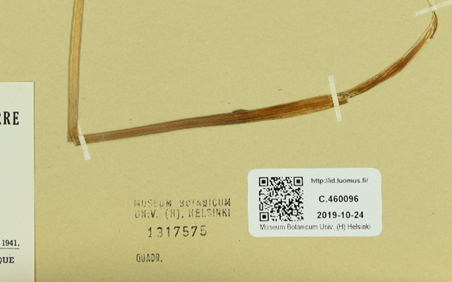Persistent Identifier Best Practices
Table of contents
Overview
The representations of specimens on the internet should be assigned a Persistent Identifiers (PID) to make them uniquely referenceable.
Recommendations
Persistent identifier (ID1)
Click here to expand: This best practice describes options for assigning a specimen a persistent identifier.
Level: Basic
Use Case: As a digitisation manager I want to identify specimens with persistent, globally unique identifiers so that I can make the digitised specimens identifiable anywhere
Recommendation:
CETAF Stable Identifiers
Discussion
All specimens have to be assigned a Persistent Identifiers (PID). Different systems have been used, but the CETAF identifier system based on HTTP-URIs and Linked Open Data principles is the most widely adopted in Europe. The system has been successfully implemented for 79 collections, some of which are listed in the following implementation examples.
A full guide to the implementation of CETAF Stable Idenifiers is available on the Biowikifarm
When using the CETAF identifier system, the institution can use their domain name in the identifiers, such as this from Luomus. In such cases, the domain names are critical and have to be maintained for long-term by the institution. There is the possibility to use centralised systems such as the services of PURL.org or DOI.org to avoid domain name changes in the URIs.
Implementation Example:
Botanischer Garten und Botanisches Museum Berlin
Example: https://herbarium.bgbm.org/object/B100277113
Catalogue: https://ww2.bgbm.org/Herbarium/
Redirect to machine-readable representation: yes
Finnish Museum of Natural History, Helsinki
Example: https://id.luomus.fi/GL.749
Catalogue: no
Redirect to machine-readable representation: no
Institute of Botany, Slovak Academy of Sciences, Bratislava
Example: https://ibot.sav.sk/herbarium/object/SAV0001234
Catalogue: https://ibot.sav.sk/herbarium
Redirect to machine-readable representation: no (no redirection by passing rdf header, but rdf is accessible here)
Museum für Naturkunde, Berlin
Example: https://coll.mfn-berlin.de/u/ZMB_Orth_BA000061S01
Catalogue: no
Redirect to machine-readable representation: yes
Muséum national d'histoire naturelle, Paris
Example: https://coldb.mnhn.fr/catalognumber/mnhn/ec/ec32
Catalogue: https://science.mnhn.fr/all/search
Redirect to machine-readable representation: yes
Naturalis Biodiversity Center, Leiden
Example: https://data.biodiversitydata.nl/naturalis/specimen/RMNH.AVES.110103
Catalogue: https://bioportal.naturalis.nl/
Redirect to machine-readable representation: yes
Natural History Museum, London
Example: https://data.nhm.ac.uk/object/a9bdc16d-c9ba-4e32-9311-d5250af2b5ac
Catalogue: https://data.nhm.ac.uk/
Redirect to machine-readable representation: yes
Natural History Museum - University of Oslo
Example: https://purl.org/nhmuio/id/41d9cbb4-4590-4265-8079-ca44d46d27c3
Catalogue: https://nhmo-birds.collectionexplorer.org/
Redirect to machine-readable representation: yes
Royal Botanic Garden Edinburgh
Example: data.rbge.org.uk/herb/E00421509
Catalogue: https://elmer.rbge.org.uk/bgbase/vherb/bgbasevherb.php
Redirect to machine-readable representation: yes
Staatliches Museum für Naturkunde Stuttgart
Example: https://col.smns-bw.org/object/S10000227722006
Catalogue: https://www.smns-bw.org/db/datenbank.php
Redirect to machine-readable representation: no
Staatliche Naturwissenschaftliche Sammlungen Bayerns
Example: https://id.snsb.info/snsb/collection/97112/153455/93009
Catalogue: https://www.snsb.info/dwb_biocase.html
Redirect to machine-readable representation: yes
Zoologisches Forschungsmuseum Alexander Koenig, Bonn
Example: https://id.zfmk.de/collection_ZFMK/2003261
Catalogue: https://www.collections.zfmk.de/
Redirect to machine-readable representation: yes (https://herbal.rbge.info/?uri=https://id.zfmk.de/collection_ZFMK/2003261)
Botanic Garden Meise
Example: https://www.botanicalcollections.be/specimen/BR0000008422330
Catalogue: https://www.botanicalcollections.be/#/en/home
Redirect to machine-readable representation: yes
Royal Museum for Central Africa
Example: https://darwinweb.africamuseum.be/object/RMCA_Vert_2011.003.P.1885-1898
Catalogue: https://darwinweb.africamuseum.be/search_specimens
Redirect to machine-readable representation: no
References
CETAF n.d., Best Practises of CETAF Stable Identifiers (CSI), Retrieved from https://cetaf.org/resources/best-practices/cetaf-stable-identifiers-csi-2/
Güntsch et al. (2017) Actionable, long-term stable and semantic web compatible identifiers for access to biological collection objects, Database, Volume 2017, 2017, bax003, https://doi.org/10.1093/database/bax003
QR/matrix codes (ID2)
Click here to expand: This best practice describes using 2D QR/matrix codes.
Level: Basic
Use Case: As a collection manager I want to find the specimen data so that I can curate specimens effectively
Recommendation:
Use a standard two-dimensional QR/matrix code embedding the persistent identifiers to barcode the specimen
Discussion
The Persistent Identifiers (PID) can be embedded into Two-Dimensional (2D) QR/matrix code. 2D code can embed more information and is easier to read when compared to the conventional one-dimensional codes. The generated code can be physically attached to the specimen or virtually added to the digitised specimen images. By scanning the code manually, the information of the specimen can be retrieved via the embedded PID. Computer applications can be used to detect and decode the code to automate the workflow in the digitisation process.
Implementation Example:
Finnish Museum of Natural History (Luomus)
Qualified URI based PID of the specimen is present as text and QR code on the imaged specimen. For example, ID http://id.luomus.fi/C.460096 is shown below.

Authors
Zhengzhe Wu and Esko Piirainen
Finnish Museum of Natural History (Luomus)
Contributors
Lisa French, Laurence Livermore, Quentin Groom
References
Güntsch et al. (2017) Actionable, long-term stable and semantic web compatible identifiers for access to biological collection objects, Database, Volume 2017, 2017, bax003, https://doi.org/10.1093/database/bax003
Citation
References
Licence
Document Control
Version: 0.2
Changes since last version: Removed recommendation for OpenDS identifier minting and updated text to reflect this. Added link to guide for CETAF Stable identifiers
Last Updated: 13 January 2023
Edit This Page
You can suggest changes to this page on our GitHub